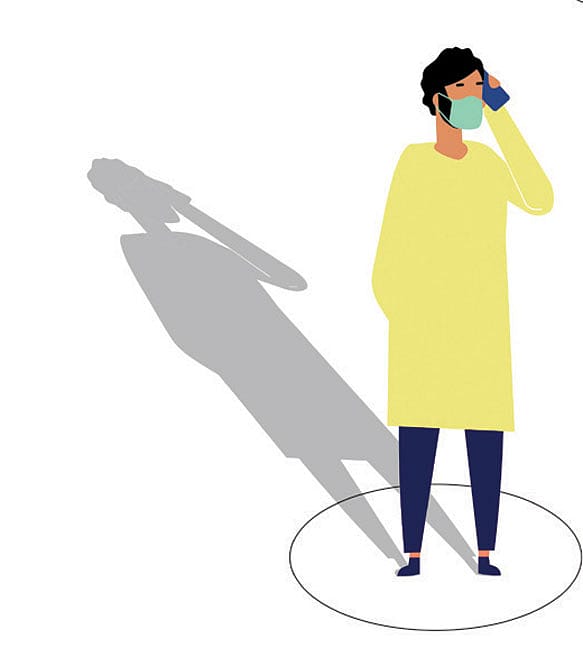Unmasking an Array of Brands

The mask has become a must-wear accessory to protect us from the viral droplets. The mask is now more essential than any one of those branded logos that adorned our bodies, and has possibly defined our identities too. In a city full of wrapped faces, the sense of normalcy has been reconfigured. Our consumerist perceptions have been challenged.We are learning to abandon movement, stop social outings, curb material cravings and its pompous display.
It is quite obvious that for the next one year or so, masks will accompany us, no matter where we go. And it is just a matter of time before the known brands start stamping their logos and start occupying the space on the most commonly visible product in the times of corona. The commodity in demand cannot be allowed to remain vacant. Visibility and appropriation of space are central to consumerism, and there is no reason to believe that masks will remain out of the consumerist purview. In fact, Louis Vuitton, Gucci, Prada have already announced their entry into mask-making. Masks have moved from an 'urgent human need to a cynically exploited asset in a global resource gab'.
Masks could soon be like any other desirable commodity on your shelf, or on your online cart.It could make a bold statement about one's consumptive capacities.Imagine a plethora of product diversification and a wide range of design and print on masks. Visualise various kinds of cuts, colours, stitches, shapes, straps, fabrics, buttons, zips on masks.Envision a hierarchy of masks that could possibly convey a sense of the prized possession.Fancy a fashion magazine cover with a masked supermodel exhibiting a new range of musk perfumes.
The commercial takeover of masks is not a fantasy—but inevitable, which is perhaps just a few vogue issues away from now.Masks perfectly mirror the consumerist idea of the self as a unit of consumption. Once done with its utilitarian role, or even while performing its functional task, masks could simultaneously accomplish their symbolic potentials. We will be consuming the mask and its display—its signage and its visuals. With a lot of ease, masks can accommodate texts and images because it is an empty surface—waiting to be populated with labels and messages.So the graduation from use-value to that of a fetish is impending.
2025 In Review
12 Dec 2025 - Vol 04 | Issue 51
Words and scenes in retrospect
Masks could be the new material platform, where popular culture opens a new account. It could soon become a new consumerist indulgence, aspiration and experience. And just like most other commodities in the consumerist landscape, the mask's meteoric rise could be guided by:multiplicity of 'choice', perpetual anticipation for the 'new', and the shrinking lifespan of its style quotient—which is a living alibi of the use-and-throw logic.
While designer masks may work with a certain idea of class, mid and low-range brands can pitch in with massy versions and variations. It would definitely find takers as masks will be central to our public appearances, regular work, and in all walks of life and leisure—irrespective of our class positions. The boring and fear-inducing surgical masks with all their mundane turquoise could give way to the eccentric, eclectic and seductive range of masks with memes, one-liners, punch lines, patterns, shades and statements. For all you know, it could be the new unifiers or differentiators or identity providers in an era of faceless bodies walking alone in the crowd.
Mask hides. It masks more than half of our face. It withholds something as rudimentary as facial identity. What makes us unrecognisable also then searches for a distinct recognition. As it shields our face, there is a temptation to announce who we are and what we believe in—through masked mass-appeals. Masks with labels and messages could make a distinction or a difference. It could provide a sense of discreetness and exclusivity, and could make heads turn. But like any other apparel and accessory, masks would also go through a constant negotiation between belonging and unbelonging; between association and disassociation;between bridging the gap and building the gap with the self and the other. Simultaneous negotiations of inclusion and exclusion are central to any commodity and its image.
In an extremely status conscious and evolving consumer society, there is a trend towards usage of commodities to communicate status messages. Coherence and demarcationare two sides of the same distinguishing agenda. In case of masks, whether the equalising force will be greater than the differentiating one, or vice-versa—needs to be seen. But masks would not remain outside the tension between the antagonistic yet complementary consumerist forces of assimilation and individuation; expressing individuality and yet seeking solidarity.
In case of masks, will modesty prevail over extravagance? Will the exaggeration of style take over the utilitarian function of masks? Or both will have a parallel run? Let us wait and observe while we mask ourselves. It is unlikely that the market will miss out on an opportunity to capitalise on branding a vacant space, which happens to be a survival kit. Will the model of buy-one-get-one-free work for masks in the next end-of-the-season sale? Will the big brands link it to corona-related charity? These are unanswered questions, but the bigger question is: are we willing or be brand-masked—with or without a cause?
